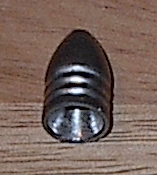i've never heard of iron cannon shot being made in drop towers, the few references i've seen seem to be by people who assumed too much.
shot towers were for making lead spheres, from bird shot up to small arms sizes. the low melting point of lead and the surface tension of the metal does indeed form spheres, the tear-drop shape so popular in myth is just that, free falling rain drops are essentially spherical, tho easily deformed by external forces.
in a shot tower lead was poured into an appropriate sized sieve or array of funnels selected to provide the correct final diameter, the height of the tower was based on how long it took the lead to harden on the way down where it terminated in a tub of water for final cooling.
after cooling the lead shot was tested for roundness on a tilted table and any that failed returned to the melt. i would guess that large balls of lead intended for case shot and cannister may have lead to the assumption that cast iron could similarly make large cannon balls.
not so, the height of tower required for the higher temp. and larger sized cannon balls molten iron would have been beyond the capabilities of the period. dropping an 18 lb. blob of molten iron into a bath of water is not something i would attempt from any practical height. the 2in. oval grape shot mentioned in the ref. above may have been just small enough for a very high drop tower, but i'd expect a bit more variation.
anyway, one of a few quotes i found on line, it followed a post where drop tower made 'cannon balls' was mentioned:
Quote:
Someone misled you. Shot (for shotguns) is made in freefall using a tower. And it basically does work the way you're thinking: it doesn't necessarily solidify all the way, but the outside does, and that's enough for it to retain its shape when it hits the water at the bottom of the tower.
Cannonballs were generally made out of cast iron. If you look at an authentic one that's in good shape, you can usually see the mold lines and sprue marks where it was poured. They were usually poured into sand molds that were then knocked away after they cooled.
Some very old cannon balls (prior to the 18th century at least) were cast bronze or cut stone rather than iron, but most people switched to iron as soon as they were able to because it's a harder, cheaper material than bronze, and easier to work with and more effective than stone. (Bronze remained as a material for the cannons themselves well into the 19th century, though, since it has greater tensile strength than cast iron and is less likely to shatter.)
Also, if you think about pouring large quantities of viscous liquid, you'd realize that "dropping" a cannonball wouldn't work... Forming spheres via freefall cooling is only practical (in normal Earth gravity) for rather small parts, where the surface area to mass ratio is low.
|
oddly enough, on a science forum discussing the making of tiny silicon balls for solar cells...
i've owned and fired muzzle loading small arms (pistols/rifled muskets) and cast my own projectiles.
in the pistols (.36 and .44 calibre) i used commercially made shot that was swaged from lead wire or cast, 000 buck (0.36" nominal) from drop towers can also normally be used as the loading process for revolvers usually will trim off any slight oversize, and the forcing cone in the barrel will swage the ball to fit the rifling. rifles would take a cloth patched ball which allowed for some variation in diameter.
the .58 cal rifled musket took a .58 calibre minie ball. one of the shot tower blurbs i read about an american civil war shot tower that mentioned it being used to make cannon balls also said it made minie balls. i tend to doubt that, having cast my own for years.

minie ball.
note the deep recess in the base, propellant gas pressure would expand the base, forcing the raised portion by the grooves into the rifling. this not only provided for the rotation, but provided a gas tight seal that allowed for more efficient use of the propellant, increasing range. they could be made a bit smaller than the bore, allowing more rapid reloading as opposed to previous round ball/patch combos that required more effort to seat the ball which was engaged in the rifling from top to bottom & thus not only had more friction, but got worse as each shot further fouled the barrel. soldiers were known to pee down the barrels of their rifles in battle to clear the fouling so they could reload.
